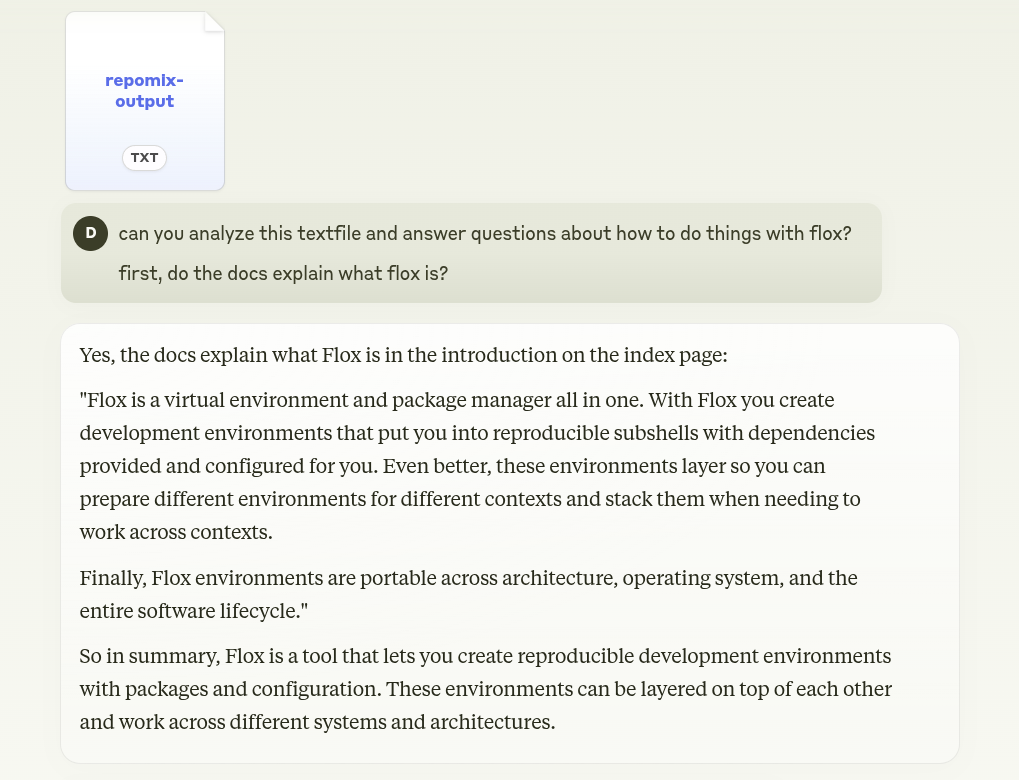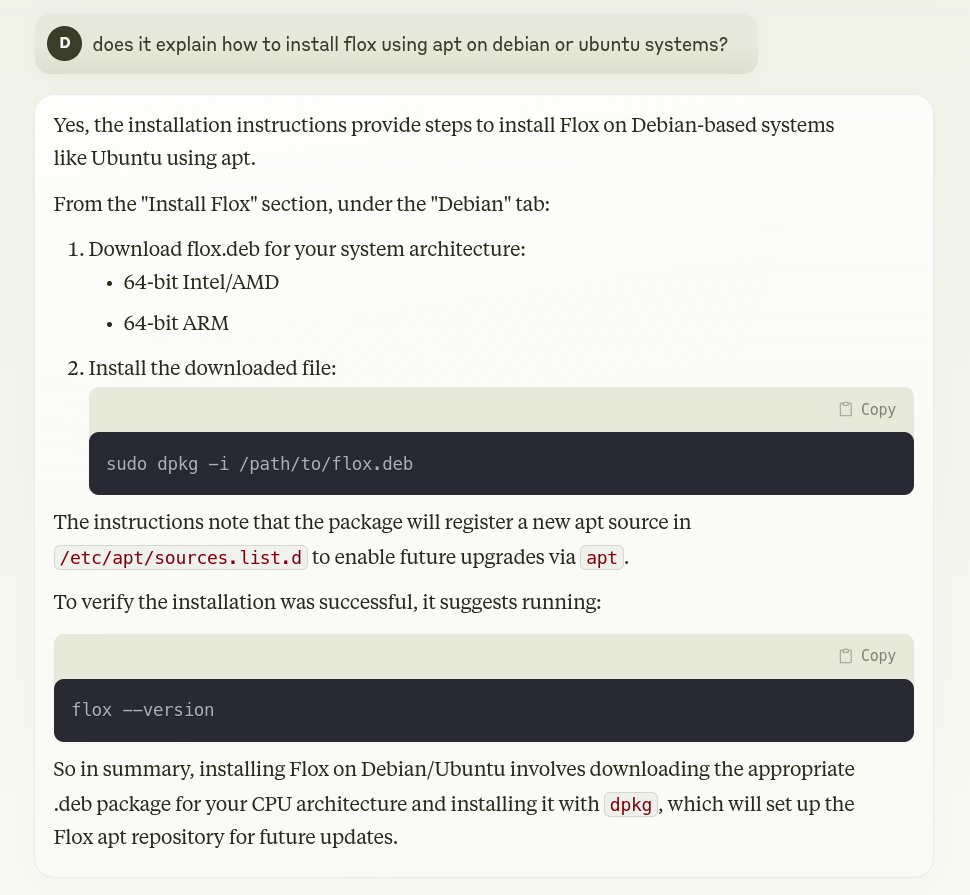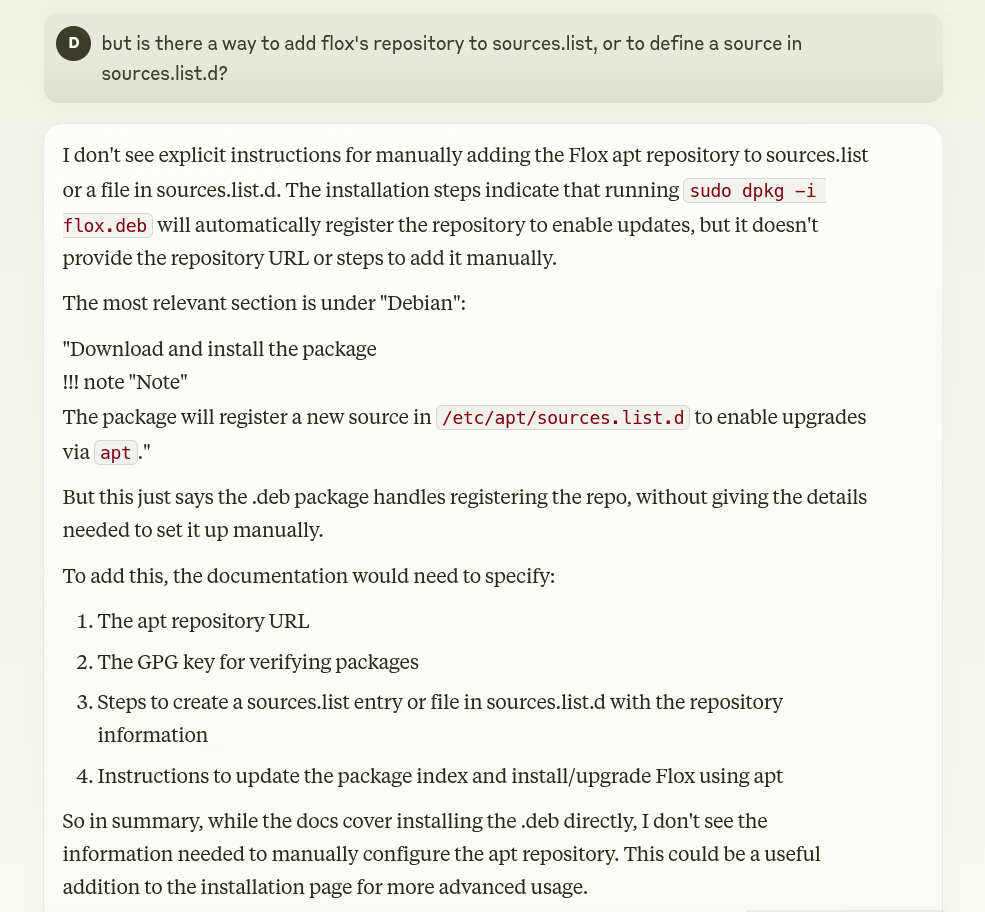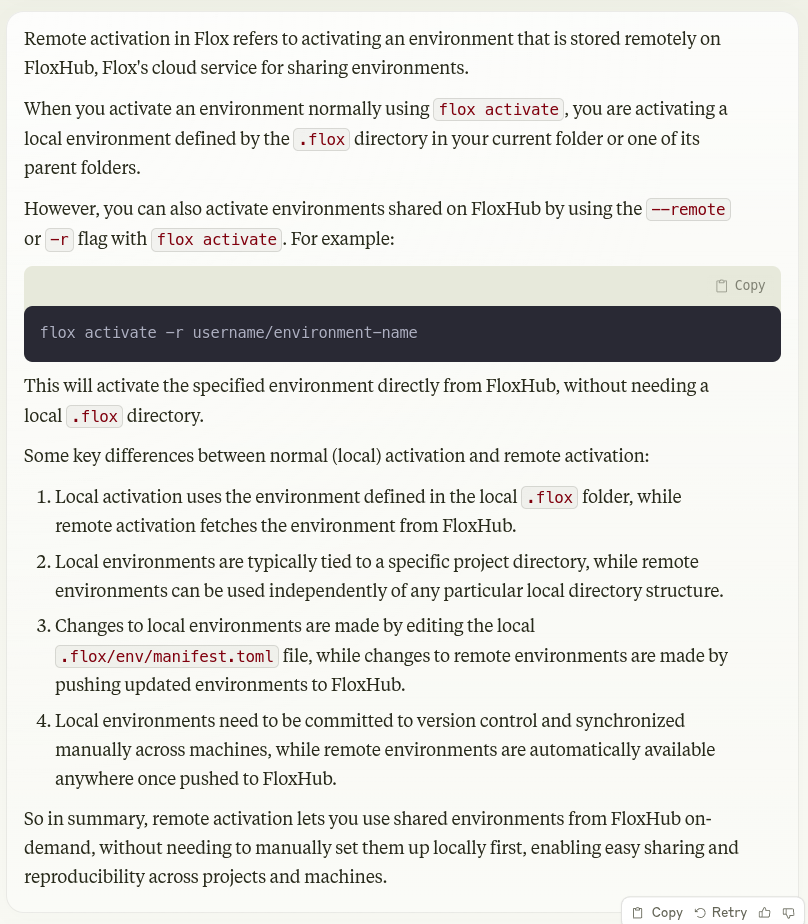This package guide covers repomix, a command-line tool you can use to condense any code repo, folder, or set of files into a raw text file, so it's easier for machine intelligence to analyze.
I knew nothing about repomix before Tom Bereknyei, Flox’s mystagogical lead engineer, told me about it.
My loss. Because if I’d had repomix when I was writing my walk-through about our portable RAG stack environment, things would have gone much, much faster. Even though it’s described as a tool for working with large language models (LLM), repomix is useful for anyone working with machine learning (ML) platforms—like AWS Sagemaker, or HuggingFace Transformers with MLflow—that rely on structured text inputs for analysis or processing.
Read on to discover how it can fit into your workflow.
Getting It
Assuming you’ve already downloaded and installed Flox, you could get repomix by:
- Running
flox install nodejsfrom within an existing Flox environment; - Activating that environment, by running
flox activate; and - Running
npx repomix.
There’s no need to do this, however, because the repomix package is also available in the Flox Catalog!
So getting repomix is as simple as running...
flox install repomix...in a new or existing Flox environment folder. This way you can work with repomix in an isolated, ephemeral Flox environment that doesn’t install or modify system-wide binaries or dependencies—like Node.js. Running flox activate puts you into an isolated subshell where you can run and use repomix.
That took all of … 15 seconds? Now that you have repomix, what can you do with it?
Let’s find out.
Using It
We’ll use a publicly available GitHub repo to showcase what repomix can do.
Just because we can, let’s use floxdocs, the GitHub repo owned and maintained by our FloxDocs team.
If you’d like to play along at home, you can clone floxdocs by running:
git clone https://github.com/flox/floxdocsYou’ve already activated your repomix environment, so after changing into the floxdocs directory, just type:
flox [repomix] daedalus@archaios:~/dev/floxdocs$ repomix
📦 Repomix v0.2.15
No custom config found at repomix.config.json or global config at /home/daedalus/.config/repomix/repomix.config.json.
You can add a config file for additional settings. Please check https://github.com/yamadashy/repomix for more information.
✔ Packing completed successfully!
📈 Top 5 Files by Character Count and Token Count:
──────────────────────────────────────────────────
1. .flox/env/manifest.lock (51,326 chars, 18,906 tokens)
2. docs/install-flox.md (27,964 chars, 6,838 tokens)
3. docs/index.md (24,315 chars, 5,719 tokens)
4. docs/concepts/flox-vs-containers.md (12,799 chars, 2,980 tokens)
5. docs/concepts/activation.md (12,459 chars, 2,855 tokens)
🔎 Security Check:
──────────────────
✔ No suspicious files detected.
📊 Pack Summary:
────────────────
Total Files: 52 files
Total Chars: 277,017 chars
Total Tokens: 73,671 tokens
Output: repomix-output.txt
Security: ✔ No suspicious files detected
🎉 All Done!
Your repository has been successfully packed.This produces a text file called repomix-output.txt, which contains cleansed, prepared raw text from the floxdocs repo. (If you’ve got JSON, YAML, etc. data structures in your repo, they’re retained in the repomix-output.txt file.) Below is the header section that repomix prepends before the actual content of the repo.
This file is a merged representation of the entire codebase, combining all repository files into a single document.
Generated by Repomix on: 2025-01-24T00:30:35.394Z
================================================================
File Summary
================================================================
Purpose:
--------
This file contains a packed representation of the entire repository's contents.
It is designed to be easily consumable by AI systems for analysis, code review,
or other automated processes.
File Format:
------------
The content is organized as follows:
1. This summary section
2. Repository information
3. Directory structure
4. Multiple file entries, each consisting of:
a. A separator line (================)
b. The file path (File: path/to/file)
c. Another separator line
d. The full contents of the file
e. A blank line
Usage Guidelines:
-----------------
- This file should be treated as read-only. Any changes should be made to the
original repository files, not this packed version.
- When processing this file, use the file path to distinguish
between different files in the repository.
- Be aware that this file may contain sensitive information. Handle it with
the same level of security as you would the original repository.
Notes:
------
- Some files may have been excluded based on .gitignore rules and Repomix's
configuration.
- Binary files are not included in this packed representation. Please refer to
the Repository Structure section for a complete list of file paths, including
binary files.
Additional Info:
----------------
For more information about Repomix, visit: https://github.com/yamadashy/repomixIf I feed repomix-output.txt into an LLM, I can ask it questions about the repo. If this were primarily a code repo, I might ask it specific questions about refactoring, or I could ask it to regenerate specific artifacts, adding comments to uncommented code (or improve comments where they exist)—stuff like that.
Since this is a documentation repo, however, I’ll ask it questions about Flox.



The final response makes sense. We do have a draft PR explaining how to add Flox's upstream repository on Debian- and Red Hat-based systems, but the person who wrote it (me) needs to address a few comments before the PR can be merged into the main branch. So this information isn’t available in the repo we cloned.
By the way, if you'd rather do this in a terminal-based workflow, instead of a web browser, we do have an anthropic example environment that you can use to query Claude using Anthropic’s APIs. You can remotely activate this environment by running flox activate -r flox/anthropic.
What does it mean to “remotely activate” a Flox environment? Let’s ask Claude:

Just in case the print is too tiny to read, here’s Claude’s concise summary wrap-up:
So in summary, remote activation lets you use shared environments from FloxHub on-demand,
without needing to manually set them up locally first, enabling easy sharing and
reproducibility across projects and machines.Caveat prompter: You need to have API credits to use Claude this way.
Summary(R)(TM)
I could show you more neat stuff with repomix—including meta use cases like having it generate documentation about the FloxDoc documentation—but I feel as if you get the point.
The raw-text files it generates are no less useful/essential for training language models, too. I don’t yet have my hot little hands on a single RTX 5090 (let alone a few dozen of them), so I’m afraid demo-ing that use case is impossible. (Jensen are you listening?) But repomix is a deceptively powerful tool you can use to condense your entire codebase into an AI-friendly format.
What you do with this is limited only by your human imagination.



